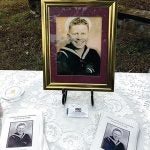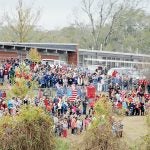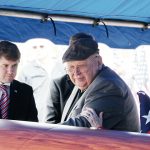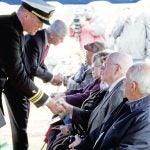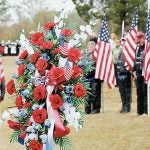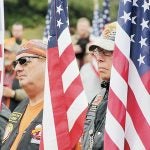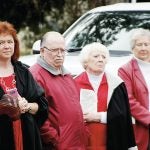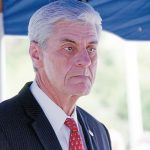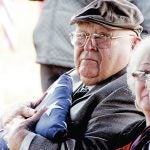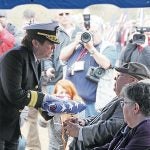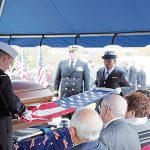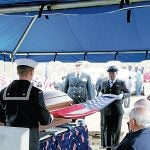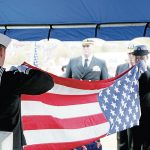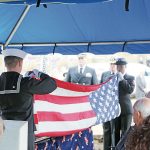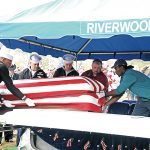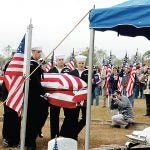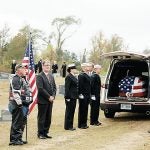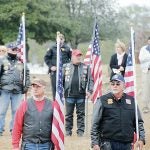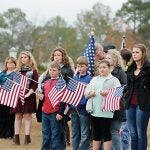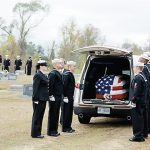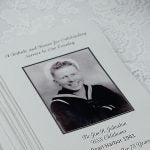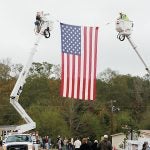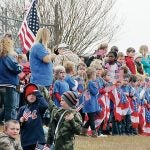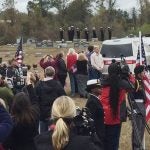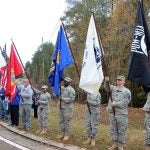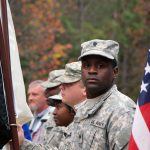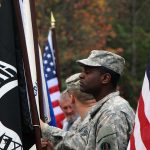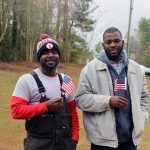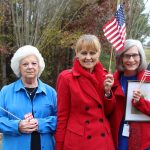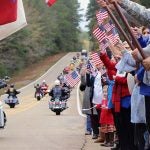Gov. Bryant: ‘May we never forget’ those who perished at Pearl Harbor
Published 4:41 pm Wednesday, December 7, 2016
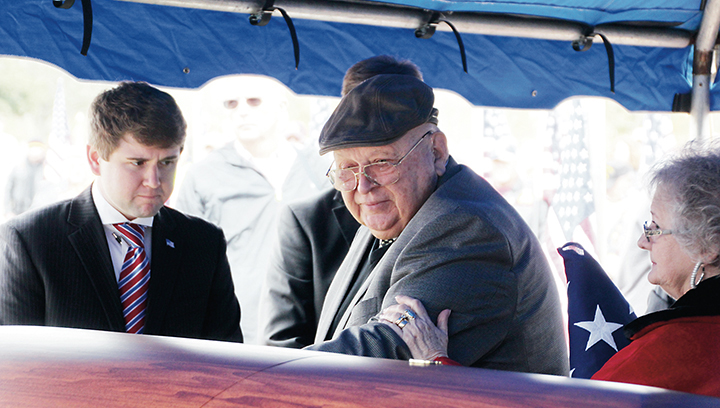
Photo by Alex Jacks/Frank Springs, the oldest living relative of Fireman 1st Class Jim H. Johnston, says one last goodbye to his uncle’s remains. Johnston perished 75 years ago on the USS Oklahoma in Pearl Harbor.
On the 75th anniversary of his death, an American hero was finally laid to rest.
Thousands of people gathered along the streets of Wesson Wednesday to watch as Fireman 1st Class Jim H. Johnston received a proper burial with full military honors.
Johnston, a 23-year-old sailor from Wesson, died along with the other 428 crewmen on board the USS Oklahoma when Japanese aircraft attacked it Dec. 7, 1941. The Oklahoma, moored at Ford Island, took several torpedo hits and quickly capsized. No single vessel at Pearl Harbor, with the exception of the USS Arizona, suffered as many fatalities.
He was the only serviceman who perished during Pearl Harbor to be buried in the United States Wednesday, which was the 75th anniversary of the horrific attack.
Johnston’s tribute began with an outpouring of support from communities in Lincoln and Copiah counties.
Residents of both counties stood on the sides of Hwy. 51 from Brookhaven to Wesson to pay their respects and wave American flags as Johnston’s funeral procession made its way from Riverwood Family Funeral Home to the Wesson Cemetery.
Every Wesson Attendance Center student stood at attention in front of the school, looking down on the cemetery from the hilltop throughout the procession and funeral.
Patriot Guard riders from across the nation led the procession along with Brookhaven and Wesson police and deputies from the Lincoln County and Copiah County sheriffs’ departments.
After Johnston arrived at the cemetery, Navy service members unloaded his casket and placed him at his final resting place near the graves of his parents and other family members.
Those in the crowded cemetery stood as the sound of rifle fire cracked the silence three times before taps was played. A flyover by Brookhaven pilot Paul Barnett, a member of the Mississippi Wing of the Commemorative Air Force in his antique Temco T-35 Buckaroo, followed. Several other aircraft planned to participate in the flyover, but were grounded because of the weather, wing leader Jason King said.
Working in precision formation, two Navy service members folded and presented the American flag from Johnston’s coffin to his oldest living relative, nephew Frank Springs, of Lucedale. Springs accepted the flag and held it to his heart as tears rolled down his face for the remainder of the one-hour service.
Gov. Phil Bryant spoke directly to Springs and his family.
“Today (Johnston) is back in Mississippi with family and friends,” Bryant said. “We have no doubt that for 75 years now, he has walked the streets of glory; that he has sailed calm and peaceful seas. We dedicate here today, his mortal remains, in his final resting place. Jimmy Johnston and those who were lost on Dec. 7 of 1941 shall never be forgotten.”
“Generations will look back upon this day, realizing that an American hero has come home,” Bryant said, choking back his own tears. “Pray for those families of the other over 400 sailors that were lost that day on the USS Oklahoma. We remember those 700 Mississippians that remain unaccounted for in World War II.
“We dedicate ourselves here today to continue that service and bring those other heroes home. From a grateful state and grateful nation, we say thank you for the years’ sacrifice. We honor Jimmy’s dedication to God and to country. May we never forget. Amen.”
Navy Chaplain Aaron Miller concluded the service with a reading from Psalm and the Gospel of John.
“Today, we honor a man who gave himself to us,” Miller said. “Though many of us do not know him, (his) sacrifice is with us each and every day that we live, as we stand here. God in his mercy has truly brought him home, not just here to Mississippi — which we do welcome him home — but into his own very courts of heaven.”
Springs, whose DNA identified Johnston, took a moment to thank all those involved.
“To the men and women who are representing the Navy here today, I thank you so much for all that you’ve done in making this happen,”’ he said. “And for the men and women of Wesson, Mississippi, thank you so much for being out here today to welcome home Jim Johnston — one of your own.
“Thank you to the Patriot Guard, who has been so honorable and so steadfast in making this happen,” Springs continued. “Thank you to those men and women. I’m sure as I stand here trying to remember things, I’ll forget somebody, but this has been one of the most momentous occasions of my existence, and I thank you all for being here this morning. I thank you all for showing honor to my uncle.”
Springs was only 3 or 4 years old when his uncle perished during the attack on Pearl Harbor. Most of his memory of Johnston comes from his mother’s recollections. Johnston was Springs’ mother’s youngest of two brothers.
“From what I can gather, he was just a happy-go-lucky individual,” he said last week.
Johnston was on his first tour of duty and had been in the Navy about a year and a half when he was killed at Pearl Harbor.
His family in Wesson considered the young man as missing in action. It took several months before it was determined he was killed in action, Springs said.
From December 1941 until June 1944, Navy personnel recovered the remains of the deceased crew, which were subsequently interred in the Halawa and Nu’uanu Cemeteries.
Staff Sgt. Kristen Duus with the Defense POW/MIA Accounting Agency said Johnston’s remains were buried with others from his crew who were unidentified. They were interred at the National Memorial Cemetery of the Pacific, known as the Punchbowl, in Honolulu. In October 1949, a military board classified those who could not be identified as non-recoverable, including Johnston.
In April 2015, the Deputy Secretary of Defense issued a policy memorandum directing the disinterment of unknowns associated with the USS Oklahoma. Two months later, personnel began exhuming the remains from the Punchbowl for analysis.
Scientists used mitochondrial DNA analysis, circumstantial evidence and laboratory analysis, to include dental comparisons, which matched his records.
When the match was made, representatives came to Springs’ home in Lucedale to deliver the news. Springs said the whole experience — from identifying his uncle to finally putting him to rest — has been overwhelming and more than he could have ever hoped.
“I don’t even have words to express it,” he said. “Coming up from Brookhaven and seeing all the people and all the kids with flags on the road, just the love and affection for their people, it’s just overwhelming. My brother and sisters and I can’t believe all that’s gone on with the support.”
Springs said he never expected so many people to care that Johnston be honored for his service.
“This that’s going on here today has just surpassed anything that we could have imagined,” he said. “I expected that we would bring Uncle Jim home and I expected that we would have a service here in the Wesson Cemetery. Little did I suspect that it would be all this.”
- Photo by Scott Boyd
- Photo by Alex Jacks
- Photo by Alex Jacks
- Photo by Alex Jacks
- Photo by Alex Jacks
- Photo by Alex Jacks
- Photo by Alex Jacks
- Photo by Alex Jacks
- Photo by Alex Jacks
- Photo by Alex Jacks
- Photo by Alex Jacks
- Photo by Alex Jacks
- Photo by Alex Jacks
- Photo by Alex Jacks
- Photo by Alex Jacks
- Photo by Alex Jacks
- Photo by Alex Jacks
- Photo by Alex Jacks
- Photo by Alex Jacks
- Photo by Alex Jacks
- Photo by Alex Jacks
- Photo by Alex Jacks
- Photo by Alex Jacks
- Photo by Scarlett Hart Public Relations Coordinator Copiah-Lincoln Community College
- Photo by Scarlett Hart Public Relations Coordinator Copiah-Lincoln Community College
- Photo by Scarlett Hart Public Relations Coordinator Copiah-Lincoln Community College
- Photo by Scarlett Hart Public Relations Coordinator Copiah-Lincoln Community College
- Photo by Scarlett Hart Public Relations Coordinator Copiah-Lincoln Community College
- Photo by Scarlett Hart Public Relations Coordinator Copiah-Lincoln Community College
- Photo by Scarlett Hart, Public Relations Coordinator, Copiah-Lincoln Community College


